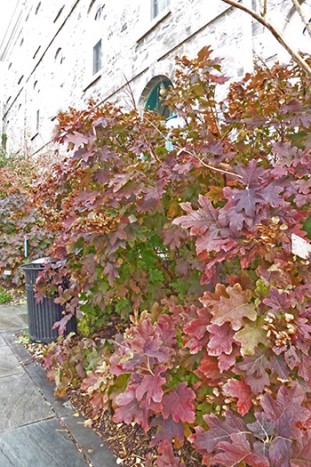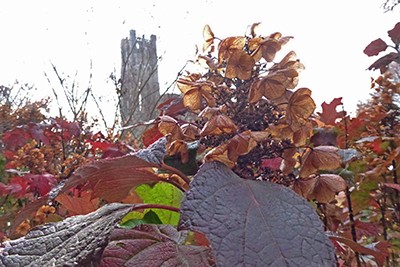Hydrangea quercifolia ‘Amethyst’
Hydrangea quercifolia is a multi-stemmed suckering shrub that can reach heights of 6 to 8 feet. Native to the Southeastern United States, it was first described by colonial Pennsylvania native botanist John Bartram, who remains the botanical authority on the species. According to sources, the genus name comes from the Greek roots hydro- meaning “water” and –aggeion meaning “vessel.” The specific epithet comes from the Latin for oak Quercus, and folia meaning leaf due to the deep lobed shape and pointed vein tips. The Royal Botanical Garden Plant Finder reference accounts for nearly 20 different cultivars available for H. quercifolia differing mostly in flower color and size. Sources say that the cultivar ‘Amethyst’ was first discovered by Michael Dirr in Cincinnati, OH. It grows to about 5’-6’ and sports large panicles of flowers with bracts that emerge white and mature to a deep red wine color.
On its own, Hydrangea quercifolia is an exceptional plant offering garden interest in every season. In winter, it has an interesting form and linear, papery, exfoliating bark. In the spring, new leaves emerge slightly downy and light green, eventually maturing into large leaves that loosely resemble those of red oak trees. In the late summer it produces 6”-8” long panicles of flowers surrounded by broad, colorful, infertile bracts. Through autumn, flowers persist and turn a light tan color while the leaves change to a long-lasting beautiful display of deep burgundies, coppers, and browns. This month the cultivar H. quercifolia ‘Amethyst’ can be seen in the full glory of its Fall display along the edge of Parrish Hall near the West Circle.







Becky Michael
Posted at 07:57h, 27 DecemberAn easy plant to grow from cuttings and so magnificent in the fall with its rich colors. When is the best time to prune? Am thinking now would be good. Does it flower on new growth?
Josh Coceano
Posted at 10:48h, 03 JanuaryHi Becky. ‘Amethyst’ is one of my favorite oakleaf hydrangeas! Flowers are formed on previous years growth so prune after flowering.